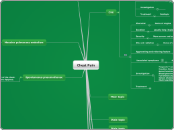по abdullah ZainAldeen 11 лет назад
374
Central topic

по abdullah ZainAldeen 11 лет назад
374

Больше похоже на это
Troponin T and troponin ICreatine kinaseRenal function and electrolytesBlood glucoseFull blood countSerum cholesterolElectrocardiography
dyspnea, sweating, anxiety, nausea, and faintness.
Often no obvious precipitant (not necessarily precipitated by exertion).- Not relieved by rest or nitrates.
Same of angina.
More severe and occur at rest.
usually long (typical duration 30 min or more).
Same of angina
Subtopic
Aggravating factors:Stress ( as exercise, emotional excitement and cold weather).Relieving factors: A) Rest. B) Sublingual nitrate relief the pain within minutes.
Retrosternal area or the throat, central and may radiate to the jaw or the arms, rarely travel below umbilicus.
Graded by New York Heart Association Classification (NYHAC) according to activity to the following:Class I : angina or dyspnea during unusually intense activity.Class II : angina or dyspnea during ordinary activity.Class III : angina or dyspnea during less than ordinary activity.Class IV : angina or dyspnea at rest
usually short (typical duration 2 – 10 min).
Crushing, heaviness, discomfort or choking sensation.